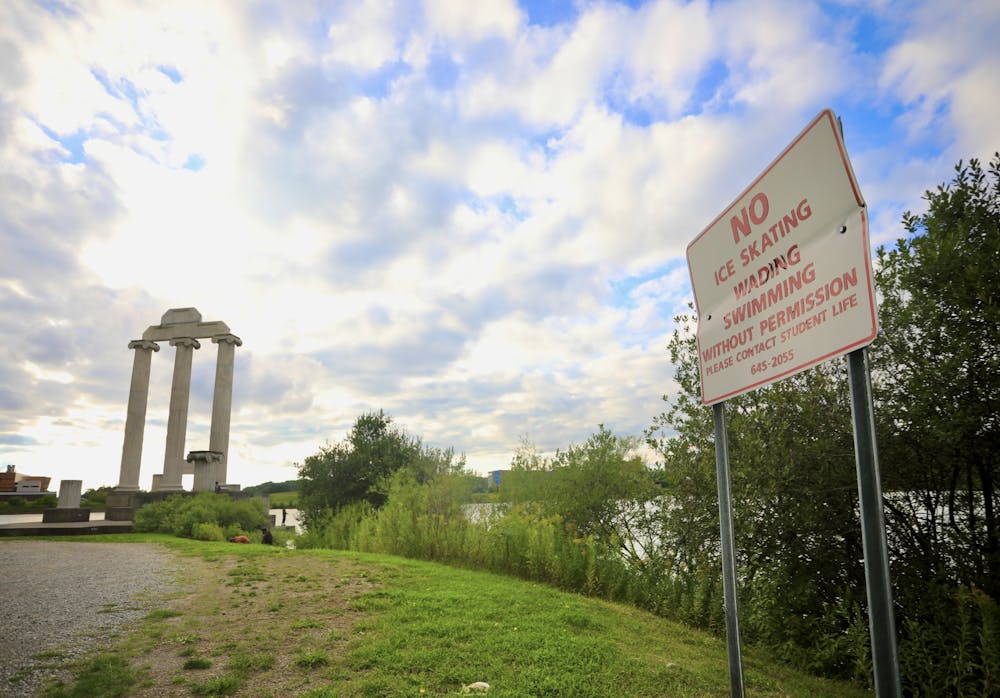For years, UB students have harbored an intense aversion to entering Lake LaSalle without the protection of a kayak’s hull. When some brave soul takes the plunge into LaSalle’s murky waters, the reactions are fearful:
“mf boutta come out w superpowers”
“Buddy contracted 40 parasites”
“Hopefully one of the bio phd’s can cure y’all’s brain eating amoeba”
But the reality of Lake La Salle’s sanitation is not as alarming as campus hysteria would have you believe.
The man-made lake, built in 1970, was designed to serve as a retention pond and stormwater collection basin. Today, it’s frequented by kayakers and used to make mud pits for Oozefest.
Though UB’s website claims that the lake “is fed by two natural springs,” a spokesperson for the UB office of Environment, Health and Safety (EH&S) says “the lake is almost entirely fed by storm runoff.” Ellicott Creek’s notoriously polluted water has no visible way to enter the lake, though a dam enables excess water to flow out of LaSalle into the creek.
Dangerous pollutants in the runoff from the surrounding campus could be cause for concern for any would-be swimmers, but Environmental Studies Program Coordinator Ira Sanford Geffner said he did not have reason to believe that any herbicides or other pollutants are present in the runoff.
Though UB does not collect data on runoff, it did note there would be other unsavory elements present.
“Significant wild geese population in the area contribute large amounts of goose excrement that likely enters the lake with the surface runoff,” the EH&S spokesperson said.
It’s no secret that many UB students’ aversion to LaSalle stems from the ostensibly copious amounts of goose poop. But Environment and Sustainability Professor Isabel Porto-Hannes says it’s nothing to worry about.
“In a healthy environment, all that should be degraded and broken down into non-pathogenic components,” Porto-Hannes said. “Animals poop and pee in the water. If a system is healthy, it will be broken down, not an issue.”
Unlike waterfowl feces, a truly frightening sight would be the presence of algal bloom — a large population of toxic algae on a water body’s surface.
Thankfully, there haven’t been any reports of such blooms in LaSalle. A 2016 Department of Environmental Conservation (DEC) report found that “water quality conditions indicated a low susceptibility to blooms, and no blooms were observed along the shoreline.”
UB does not take samples or analyze for algal blooms and says it is not required to do so by any regulating authority.
Though no algal blooms are reportedly present, the 2016 DEC report noted that aquatic life may be stressed by low oxygen levels, caused in large part by the poor clarity of the water, and that the habitat may be threatened by invasive plants.
“I tried fishing there once with groups, and the water was just so clouded. It was a waste of time. I tried to collect invertebrates there once, and it’s not good at all,” Geffner, the Environmental Studies program coordinator, said. “Those systems are not prolific in terms of life. You’ll find turtles there, and certainly there are fish there and crayfish that can tolerate that type of lower-oxygen-level environment.”
There do not appear to be any natural threats to swimmers. Civil engineering professor Ian Bradley says that oxygen, pH, alkalinity and total suspended solids (TSS) water quality parameters are within normal measurement levels for local and New York State water bodies.
But the coast isn’t quite clear for would-be swimmers. Unnatural hazards — including traffic cones, stools, satellite dishes, pizza boxes, a myriad of beer bottles and countless other items — have all been thrown into the lake at one point. The vantage point at Baird Point makes it abundantly clear that some on campus have no problem littering in the lake. Even the 2016 DEC report observed “a significant amount of garbage.”
But even if you’re willing to roll the dice and swim in Lake LaSalle, UB won’t let you. The university bans swimming due to potentially hazardous shoreline conditions, a lack of water clarity and no lifeguards or supervision.
The university hasn’t been shy about enforcing that rule in the past. One UB student was arrested in 2009 for stripping to his underwear and swimming across the lake to get to the front of the line for Fall Fest.
Volunteers support UB in periodic campaigns to remove trash and debris around the shore. In 2018, Molly Dreyer, a 2017 UB environmental engineering graduate, assembled a team to plant more than 1,000 native trees, shrubs, and aquatic plants to stave off erosion and improve biodiversity.
At the end of its report, the DEC concluded that swimming, if allowed, would only be impacted by very low water clarity.
Dominick Matarese is the senior features editor and can be reached at dominick.matarese@ubspectrum.com

Dominick Matarese is the Senior Features Editor at the Spectrum. He enjoys writing about interesting people, places, and things. In addition to running an independent blog, he has worked worked with the Owego Pennysaver, BROOME Magazine, the Fulcrum Newspaper, and Festisia. He is passionate about music journalism and can be found enjoying live music most weekends.





